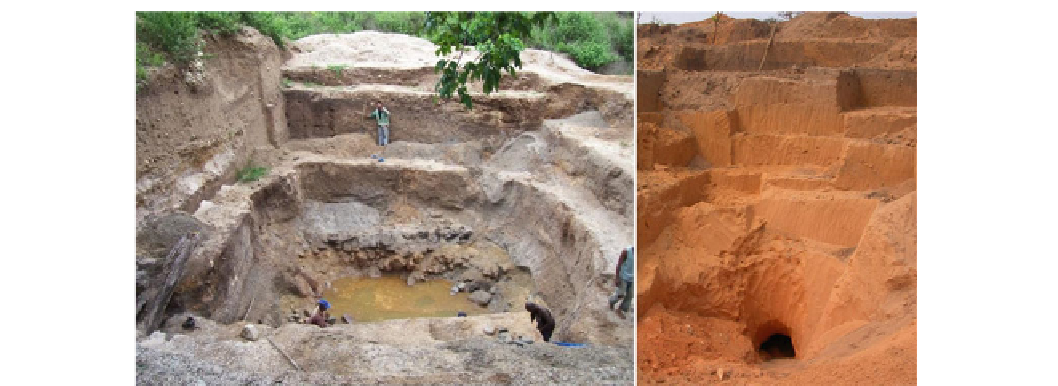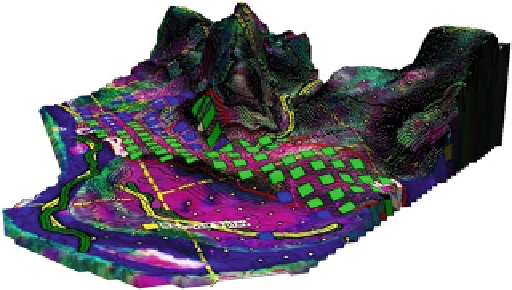Geology Reference
In-Depth Information
Fig. 16.15
On the
left
overburden sand of some 4.5 m on basal gravel at target K33S—miners at top of gravel layer. On the
right
silicified
conglomerate boulders at the base with overburden sands lower down the Kwango at target K56 near Kitangu (photo Ward)
approximate critical diamond size 0.01 cts/stn) to no. 23
(10.3 mm or 9.2 cts/stn), weighed and photographed. Infor-
mation pertaining to these parcels, such as diamond size,
colour and shape is presented in Tables
16.2
and
16.3
.
In total 2,734 stones were examined representing 282.41
cts. The average stone size of the total population is 0.103
cts/stn (Table
16.2
).
Maurice Barker, a South African diamond evaluator,
classified these data into three broad areas of origin,
evaluated these accordingly and presented its size frequency
distribution plots (Fig.
16.17
). Group 3 (Flats 5 and 8)
representing the most upstream areas; Group 2 (Second
splay, K56, Flats 13 and 14) being part of the more central
areas, and Group 1 (K97 and K105) the most downstream
deposits.
Slight variations of the diamond populations between the
three groups were noticed and these are believed to be
related to different geomorphic settings (Fig.
16.9
). For
instance Group 3 diamonds are from a wide section of the
Kwango Valley where concentration mechanisms are least
effective which explains the smallest average stone size. The
Group 2 diamonds are from a stretch of river which is
relatively narrow and is characterised by many artisanal
workings, and the Group 1 diamonds were derived from an
area where the valley begins to widen and forms a sediment
splay with bigger diamonds being trapped in the proximal
part of this splay.
Overall the diamond population is well sorted and
variations in stone sizes are generally small ranging between
0.074 to 0.118 cts/stn with an average stone size of 0.103 cts/
stn (Fig.
16.18
). The largest stone was 4.72 cts and only 14
diamonds of over 1.2 cts in weight (diamond sieve size no.
15) were recovered out of the total population (2,734
diamonds). Eleven of these were recovered in a relatively
narrow river section from the Group 2 setting, two from the
Fig. 16.16
Example of the pitting/drill holes density over a 3D view
of the second splay looking south. Average overburden thickness is
11 m. Gravel attained (
Green squares
) and holes abandoned due to
ground water problems (
Blue squares
). Distance between pits is 200 m
between slightly to extensively abraded with a higher per-
centage of extensively abraded grains being recovered from
the more downstream targets of the project area (K48, K52
and K56). Since no kimberlitic grains were found in gravel
collected from the tributaries flowing into the Kwango it
suggests that the source of all the recovered grains are the
kimberlites in Angola, transported by the Kwango/Cuango
River.
16.5.4 Diamonds
Artisanal workers digging for alluvial diamonds is common
in the mineral-rich regions of Central Africa and the
Kwango Valley is no exception. A systematic survey of the
alluvial diggings on the river terraces by local artisanal
workers was conducted. Diamond parcels from artisanal
operations on nine targets were screened, using diamond
sieve sizes no. 1 (Aperture diameter of 1.09 mm and


Search WWH ::

Custom Search